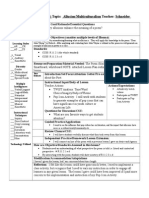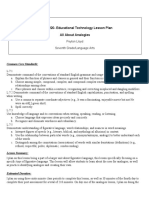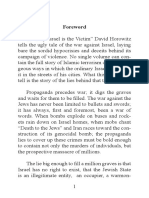Allusions
Uploaded by
api-482428947Allusions
Uploaded by
api-482428947Date: October Course: LA Grade: 20-1 Length 1.
5 hours
of Lesson:
13th
PROGRAM OF STUDY OUTCOMES
2.1.2.f . interpret figurative language, symbol and allusions; recognize imagery; and explain how imagery contributes to
atmosphere, characterization and theme in a text
OVERVIEW OF LESSON:
● 45 mins read, quotes, journal entries
● Introduction to allusions
● Examples of allusions
● Allusions in “Scythe”
GOAL(S) OF LESSON:
● The students understand what Allusions are and are able to identify them in texts
LEARNING OBJECTIVES:
By the end of this lesson students will be able to...
● Understand what allusions are
● Pick out allusions in texts
● Understand examples allusions in “Scythe” so far
INQUIRY QUESTION / GUIDING QUESTIONS:
● How does death impact the human experience?
o This is the overall unit question
MATERIALS AND EQUIPMENT:
● Projector so that I can show the video and powerpoint
● Allusions worksheet print out
PREPARATION AND LOGISTICAL CONSIDERATIONS:
● Have everything ready on the projector
PROCEDURE:
Introduction Time
● 45 mins read, quotes, and journals
50 mins
● Quick write
o Give students 2-3 minutes to make a list of what they think are the most famous
or well known books or stories of all time (in all of human history).
● As a class:
o I ask for a few items off the student’s list. There will likely be allusions between
these works. The teacher should call attention to this. For example, Hamlet has
several Biblical allusions in it. “That skull had a tongue in it, and could sing
once. How the knave jowls it to the ground, as if 'twere Cain's jawbone, that did
the first murder!” (Hamlet, 5.1.34). Ask students if they can spot references between
two works, and what they are.
● Why do we make reference to these things in passing? What might be a benefit to
referencing this?
Body Time
Definition of Allusion ● Show the video with the definition of allusion and some 3 mins
examples
● Stop the video when it writes the definition so that students
can write the definition of Allusion in their notes
● https://academy4sc.org/video/allusion-i-understood-that-refer
ence/
See if you can pick ● Provide students with the allusions worksheet 10-15 mins
out the allusions ● Students can work together to complete is
● In 5-10 mins, take it up as a class
Allusions in “Scythe” ● Ask students to generate a list of allusions in their groups that 5 mins
- student generated you can think of with “Scythe” - do you notice any?
● Ask students to share
Allusions in “Scythe” ● On a powerpoint slide, I will have a list of three 15 mins
teacher examples allusions in “Scythe” that we’ll go over as a class
and students take notes on
Conclusion Time
● Fist to 5 2 mins
o How are you feeling with Allusions from a fist to 5?
ASSESSMENT:
FORMATIVE ASSESSMENT:
● Make note of any of the students who put a low number for the fist to 5 and check in with them later
SUMMATIVE ASSESSMENT:
● Quotes - students have to select a quote in their log that has an allusion
DIFFERENTIATION:
INSTRUCTION:
● Direct instruction
● Video
● Group work
● Discussion
REFLECTION OF LESSON:
What are three things that went well?
What did not go well / felt clunky?
Why?
What can you do next time?
You might also like
- Lesson Plan Template LTM-612: Add Lesson Elements in Blank Boxes Below Explanation/directions100% (1)Lesson Plan Template LTM-612: Add Lesson Elements in Blank Boxes Below Explanation/directions5 pages
- Texas A&M University-Commerce Daily Lesson Plan FormNo ratings yetTexas A&M University-Commerce Daily Lesson Plan Form2 pages
- Teaching English to Young Learners: Teacher DevelopmentFrom EverandTeaching English to Young Learners: Teacher Development4/5 (5)
- Ued495-496 Christina Lewis Developmental ArtifactNo ratings yetUed495-496 Christina Lewis Developmental Artifact3 pages
- EDUC 2220-Educational Technology Lesson Plan All About AnalogiesNo ratings yetEDUC 2220-Educational Technology Lesson Plan All About Analogies6 pages
- ENG-10 Q3 Lesson 5.2 Figurative LanguagesNo ratings yetENG-10 Q3 Lesson 5.2 Figurative Languages8 pages
- Millicent Atkins School of Education: Common Lesson Plan TemplateNo ratings yetMillicent Atkins School of Education: Common Lesson Plan Template8 pages
- Milliken's Complete Book of Instant Activities - Grade 1: Over 110 Reproducibles for Today's Differentiated ClassroomFrom EverandMilliken's Complete Book of Instant Activities - Grade 1: Over 110 Reproducibles for Today's Differentiated Classroom5/5 (1)
- Milliken's Complete Book of Instant Activities - Grade 2: Over 110 Reproducibles for Today's Differentiated ClassroomFrom EverandMilliken's Complete Book of Instant Activities - Grade 2: Over 110 Reproducibles for Today's Differentiated Classroom4/5 (1)
- Author To Her Book by Anne Bradstreet LPNo ratings yetAuthor To Her Book by Anne Bradstreet LP4 pages
- Milliken's Complete Book of Instant Activities - Grade 6: Over 110 Reproducibles for Today's Differentiated ClassroomFrom EverandMilliken's Complete Book of Instant Activities - Grade 6: Over 110 Reproducibles for Today's Differentiated ClassroomNo ratings yet
- Reflective Lesson Plan (Video Lesson) Personification and HyperboleNo ratings yetReflective Lesson Plan (Video Lesson) Personification and Hyperbole7 pages
- Thematic Unit - Figurative Language in The IliadNo ratings yetThematic Unit - Figurative Language in The Iliad19 pages
- Lena Archer Jarred Wenzel Curriculum Ideology AssignmentNo ratings yetLena Archer Jarred Wenzel Curriculum Ideology Assignment9 pages
- 01 Lal Kitab Concept - Posheeda Teen - Veiled Trio100% (3)01 Lal Kitab Concept - Posheeda Teen - Veiled Trio3 pages
- Developing, Deploying, and Monitoring in The CloudNo ratings yetDeveloping, Deploying, and Monitoring in The Cloud19 pages
- Father+of+Spirits+Lyrics+by+Theophilus+Sunday+%7C+African+Gospel+Lyrics_1736804420460No ratings yetFather+of+Spirits+Lyrics+by+Theophilus+Sunday+%7C+African+Gospel+Lyrics_17368044204606 pages
- Unlocking Language Strategies For Teaching English As A Foreign LanguageNo ratings yetUnlocking Language Strategies For Teaching English As A Foreign Language10 pages
- Foundation Course Semester I Overview of Indan SocietyNo ratings yetFoundation Course Semester I Overview of Indan Society19 pages
- Differential Mode of Association ReadingNo ratings yetDifferential Mode of Association Reading11 pages
- Decrypting The Most Mysterious Book in The History100% (1)Decrypting The Most Mysterious Book in The History8 pages
- NIACL Administrative Officer (AO) Mains 2021 Previous Year PaperNo ratings yetNIACL Administrative Officer (AO) Mains 2021 Previous Year Paper126 pages
- CSE 1002: (Problem Solving and Object Oriented Programming)No ratings yetCSE 1002: (Problem Solving and Object Oriented Programming)3 pages
- Forensic Analysis of Windows Registry Against IntrNo ratings yetForensic Analysis of Windows Registry Against Intr15 pages
- From Idea To App - Creating IOS UI Animations and Gestures Voices That Matter100% (1)From Idea To App - Creating IOS UI Animations and Gestures Voices That Matter265 pages






































































































